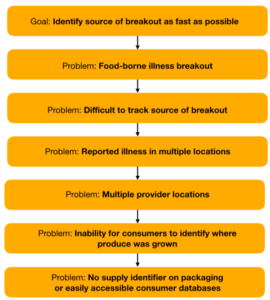“We need to adopt blockchain technology. It’s going to solve all of our problems!” How many times over the past two years have you heard a colleague say this when exploring options for solving some core business problem? Blockchain, mostly due to the hype surrounding Bitcoin, has become the “go to business strategy.” Fueling the hype are the potential game-changing ways companies could use the technology — from rolling out more efficient and secure logistics tracking to new ways of storing data and making contracts (“smart contracts”).
When considering blockchain, it’s important for companies to cut through the hype and remember that they aren’t investing in a blockchain, they are investing in a solution to a business problem.
However, many companies grapple with what investment to make and are puzzling over whether adopting blockchain would actually help solve their specific problems. To determine whether blockchain is the best path forward, companies should consider these two questions:
1. What business problem would adopting blockchain address?
This question is often skipped in all the hype and excitement surrounding blockchain. There are a few clear-cut ways to identify a problem blockchain could tackle — the most direct approach is to use systems thinking.
Systems thinking, according to TechTarget, is “a holistic approach to analysis that focuses on the way that a system’s constituent parts interrelate and how systems work over time and within the context of larger systems.” This is key, Mark Esposito, Professor of Business & Economics at Hult International Business School, argues as we “are often trained to analyze problems by breaking them down into their component parts, looking for hierarchical relationships and attempt to identify linear causality.” Professor Esposito continues, “Unfortunately, we live in a world were problems are complex, involving many different variables, and having multiple, complex dynamic relationships that cannot be defined linearly. Systems thinking is a tool that allows us to successfully analyze these wicked systems holistically to find the leverage needed to create meaningful change.”
John Carrier, Senior Lecturer of System Dynamics at the MIT Sloan School of Management, has done a great job of illustrating systems thinking, to make it easier for companies to break problems down into multiple, more detailed levels.
Let’s now look at a real-world example of how systems thinking can be used to answer the question: What business problem might be addressed by adopting blockchain? Contaminated produce, which accounts for 46% of all foodborne-associated illness and 23% of foodborne-associated deaths, is a major problem facing the food industry. It often takes companies months to find the source of the contamination and results in significant costs. This issue has garnered a lot of attention recently, like the 2018 E. coli-contaminated romaine lettuce outbreak, which took investigators three months to track down and led to 205 reported illnesses and five deaths. Figure 1 breaks down the many levels of the problem.
Figure 1:

Walmart, which is major player in the food industry, has also been grappling with this problem. In September 2018, it began requiring salad vendors to join a blockchain-based supply chain in an attempt to better trace foodborne illness. Walmart wanted to identify the source as fast as possible to limit the impact on both public health issues and sales revenue. By breaking down the problem into multiple components, Walmart was able to identify the core problem of not having a supply identifier on packaging or an easily accessible consumer database.
Only after deconstructing the business problem, should companies then ask the question: Is blockchain the solution? Without the use of systems thinking, organizations run the risk of developing solutions for the wrong problem, which could potentially lead to wasted resources. With the implementation of blockchain, Walmart was able to address their core problem, giving Walmart and consumers a verifiable, unchangeable record of their produce source and allowing for speedy identification.
2. Can your company leverage existing tech to make the roll-out of blockchain more effective?
Once your company has identified the problem, then survey the technology you currently have in place. Some of the most successful blockchain adopters have built it on top of existing company products and platforms. This strategy requires less investment in infrastructure (both capital and people), provides a lower-cost solution, and can mitigates risks.
User experience and customer feedback are two prime areas where companies can foster adoption easily without reinventing the wheel. For example, Disney used blockchain to improve their customer service experience by integrating it with their Magicbands (Disney guests use Magicbands as hotel keys, ride registration passes, etc.). With the goal of further improving customer service, the integration of blockchain now allows Disney staff to see the names of guests up to 40 feet away. By building on top of an existing technology, Disney was able to roll out the new tech effectively by developing their own platform Dragonchain. The Disney experience shows the importance of companies having implementation plans that identify key milestones and measures, along with communicating with staff or users — as transparency reduces ambiguity.
Asking questions won’t result in a comprehensive blockchain strategy for your company, rather they are an essential first step towards effectively addressing a core business problem.
